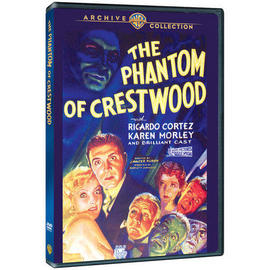
No
Clue (2013/E1 DVD)/The
Phantom Of Cresswood
(1932/RKO)/The
Phynx (1970/Warner
Archive DVDs)
Picture:
C+/C/C+ Sound: C+/C/C Extras: C/D/D Films: C
PLEASE
NOTE:
The
Phantom
Of Cresswood
and The
Phynx
are now only available from Warner Bros. through their Warner Archive
series and both can be ordered from the link below.
Here
are three different mystery, spy, genre spoofs to know about...
Carl
Bessai's No Clue
(2013) is a spoof of the old detective set-up by having novelty guy
Leo (Brent Butt) take the case of a beautiful, distraught gal (Amy
Smart) because she mistakes him for a real detective who is on
vacation. She is in the wrong office, correct building and is about
to get zero help. The film has a set-up that we have seen before and
could have been updated with ease and the actors are cast well
enough, but the script is a mess, the makers don't know what they are
doing and the result is 96 minutes of missed opportunities, missteps
and bad moments that make Dead
Men Don't Wear Plaid look
better that ever. They also don't seem to have any idea what Film
Noir really is. Too bad the title is so prophetic.
Extras
include a feature length audio commentary track and a Behind The
Scenes featurette.
J.
Walter Ruben's The Phantom
Of Cresswood
(1932) was produced by David O. Selznick and pushes Richard Cortez as
the male lead of the moment in a this tale of a mystery radio series
that leads to a theatrical movie, then a real murder in high society.
Despite the horror movie cover (nice poster art), this is as much a
drama and tale of high society types as anything, serving as a time
capsule of such. It is interesting to watch, yet has limited
suspense and frankly comes at the beginning of the sound era of the
genre it tackles. Still, it is a curio worth a look for fans and
intelligently done.
There
are no extras.
Finally
we have Lee H. Katzin's The
Phynx (1970), a film that
comes at the end of a cycle of gaudy 1960s, overproduced 1960s spy
comedies (which include mystery elements) that included everything
from Candy
to Modesty Blaise
to the 1967 Casino Royale
and any other film trying to (with little to no success) be the next
Dr. Strangelove.
Bizarre and not very memorable, Jerry Leiber and Mike Stoller
(obviously trying to have the success Burt Bacharach and Hal David
did with their Casino
Royale soundtrack)
created not very memorable music that barely fits into a
barely-existing narrative that starts with a spy from the West trying
to get behind the Iron Curtain to no avail.
After
colorful credits, the next plot to break into the Curtain is to put
together the next Beatles by a CIA-sponsored version of The Monkees
(more or less) called The Phynx. The recruiting, like much of the
film, is supposed to be amusing, but the script is uninspired, the
actors try their best with little effect and this was never a great
film, now dating very badly. Great character actors like Lou
Antonio, Mike Kellin, Michael Ansara, George Tobias and the young
actors playing the would-be supergroup (yea, rock-n-roll will get the
people to rise up against them commies!) adds big names in guest
turns (or less) like Joan Blondell, Huntz Hall, Ruby Keeler, Rudy
Vallee, Johnny Weismuller, Maureen O'Sullivan, Butterfly McQueen and
Leo Gorcey that was old hat by the time it was released. It is at
least a good-looking film, odd as it is and Katzin
did better next with Le
Mans
(reviewed on Blu-ray elsewhere on this site) though not universally
so. If only the writers understood the genres (spy, musical.,
counterculture) involved, this could have maybe worked.
There
are no extras.
The
anamorphically enhanced 1.85 X 1 image on Clue
and anamorphically enhanced 2.35 X 1 image on Phynx
look pretty good, though Phynx
is very narrowly better, but not enough to have a higher rating.
Clue
can still look weak in parts it should not, while Phynx
has is from a pretty good print and has good color and actually
issued at the time in 35mm dye-transfer, three-strip Technicolor film
prints that must have been nice. The 1.33 X 1 black and white image
on Cresswood
is a little soft and has some flaws as expected for a film its age,
but it still sports some nice shots, the kind Clue
cannot quite imitate despite its best efforts. Still, it is too soft
a little too often. The lossy Dolby Digital 5.1 on Clue
does outdo the lossy Dolby Digital 2.0 Mono on Cresswood
and Phynx
as expected, but all would likely sound better in lossless
presentations.
As
noted above, you can order either of the Warner Archive DVDs, The
Phantom
Of Cresswood
and/or The
Phynx,
go to this link for them and many more great web-exclusive releases
at:
http://www.warnerarchive.com/
-
Nicholas Sheffo